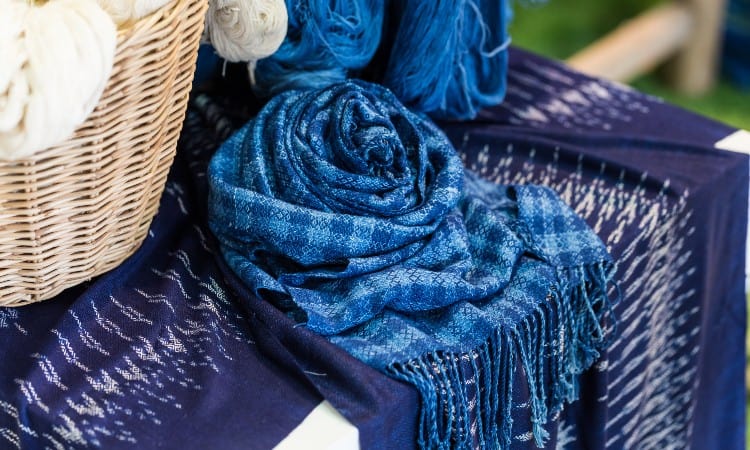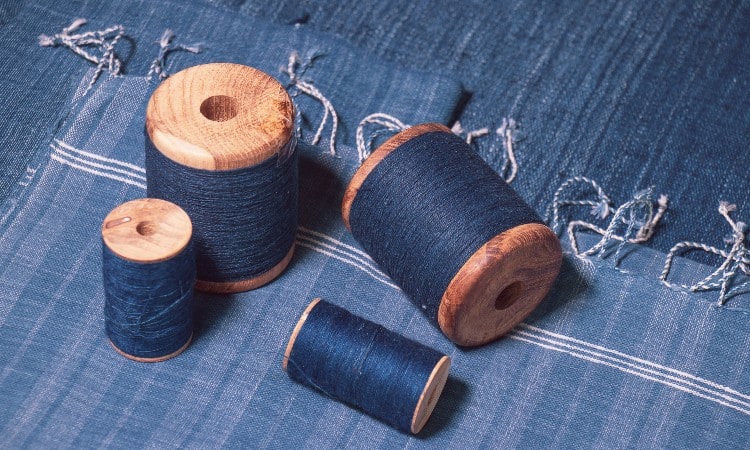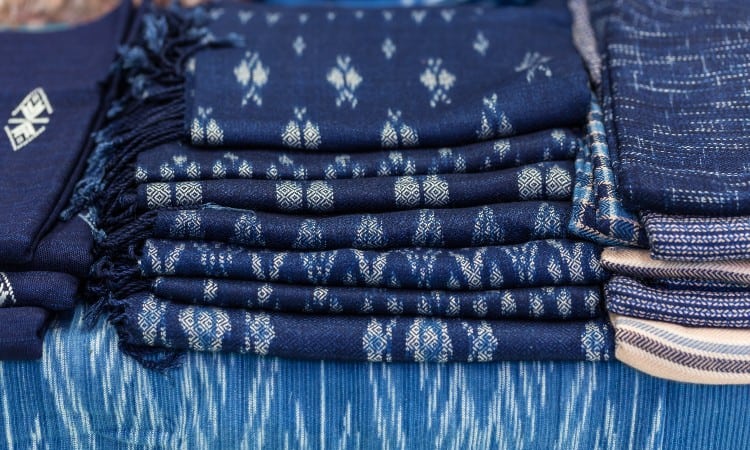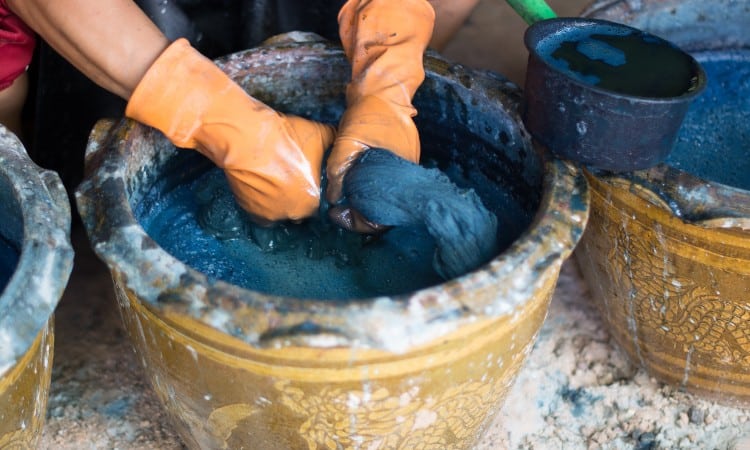Whether you are interested in textile arts or simply trying to select a unique fabric for a summer dress, you may find yourself wondering why some kinds of cloth look so different from others. You may not know that different dyeing methods create dramatically varied kinds of cloth. For example, what is the yarn-dyed fabric?
Yarn-dyed fabric is made out of pre-dyed yarns woven into a pattern. It differs from piece-dyed fabric, which is dyed after the cloth is woven. Popular yarn-dyed patterns include gingham check, dobby cloth, and some plaids.
In this article, you’ll find out how manufacturers make yarn-dyed fabric, how this unique kind of cloth is different from other materials, and how to use this cloth yourself!

What is Yarn-Dyed Fabric?
Yarn-dyed fabric features designs created by weaving colored threads together to make patterns. Dyeing the yarn before weaving it into cloth creates a unique, artisanal look that differs greatly from the typical printed designs you see on piece-dyed fabric.
To dye the yarns, manufacturers typically use a method called package dyeing. This technique soaks spools of tightly wound plain yarns in the dye solution. Just like in Home Depot, when you need to get a bucket of paint mixed up, the manufacturer uses a computer to code in specific colors for the dyes.
Once dyed, the manufacturer can turn the yarn into cloth in several different ways. The cool, special quality of yarn-dyed fabrics is that the design is woven into the cloth. The more prevalent piece-dyeing method essentially prints a design onto a whole section of cloth.
You will typically find yarn-dyed fabrics featuring stripes, plaids, gingham checks, dotted or cross patterns, or ikats. (In case you’re wondering, ikats are a special method of dyeing and weaving that knot clumps of threads together for dyeing and keeping them together in the weaving, creating a symmetrical design. Think of the Aztec-style arrowheads you might find in a wool blanket).
Tiny crosses, dots, or lines characterize a special kind of yarn-dyed fabric called dobby cloth.
Gingham check weaves together two different colors of yarns in a cute checked pattern.
Denim is technically a yarn-dyed fabric as well. Weaving blue and white threads across each other creates the familiar blue-grey shade that you know and love from your favorite stretchy jeans or chunky fall jacket!.
In general, though, you can expect to note these characteristics in yarn-dyed fabrics. First, you will often find a tapestry-like band of contrasting color yarns on the reverse side. The front and back of this cloth will not match.
Second, many yarn-dyed fabrics have a slightly rougher, more hand-made appearance than the average roller-printed piece-dyed fabric. They have a real texture, and often the woven designs are slightly raised from the rest of the material.
Finally, some yarn-dyed fabrics have an artisanal, rustic look to them. This is what makes them so appealing!
What’s the Difference Between Yarn-Dyed and Piece-Dyed Fabric?

The main difference between yarn-dyed and piece-dyed fabric is that yarn-dyed fabric is dyed before the cloth is woven, and piece-dyed fabric is dyed after the cloth is woven. Yarn-dyed fabric is made by weaving together colored threads into woven designs. Piece-dyed fabric usually has a design printed onto it by giant rollers.
Polyester curtains printed with giant tropical flowers are piece-dyed. A cotton peasant-style blouse with a stripe of flowers across the bottom (and a tapestry-like unwoven stripe of threads on the reverse side) is yarn-dyed, with the pattern woven into the material.
Now, the piece-dyed fabric can certainly look lovely! If you lie quilting, you probably love the aisles of lovely quilting cottons in a sewing store. Without the advanced textile sciences of piece dyeing, you wouldn’t have thousands of different printed designs to choose from as you design your quilt!
That said, yarn-dyed fabrics also have their charms. They carry on the millennia-old skill of weaving designs into cloth.
Have you ever visited a historical reenactment location to see how people in the middle ages, or the 1700s, worked and lived? You probably saw the weaver slowly building a design on a wooden loom, one row at a time!
Though yarn-dyed fabrics today are typically made on industrial looms, they have the same characteristics as the hand-crafted fabrics people have made for thousands of years.
These types of cloth have a more pronounced texture and more defined pattern than most piece-dyed kinds of cloth. They will never have the slightly computer-graphic-look of some printed materials.
What is the Difference Between Fabric and Yarn?
The main difference between fabric and yarn is that fabric is the whole, completed piece of cloth. Yarns are the individual threads that make up the cloth.
You may think of yarn as a skein of soft wool for knitting sweaters, socks, and mittens. However, in textile manufacturing lingo, yarns are the individual threads that make up a piece of fabric.
In any section of woven cloth, you have warp and woof threads. The warp threads run lengthwise and the woof threads run across the fabric. The warp and woof threads are the yarns of the fabric!
Yarns come from many different substances, both natural and synthetic. Interlocked fibers twisted together make yarns or threads. Today, you can find three major categories of yarns.
Plant-based yarns feature popular materials such as cotton and linen. Animal-based yarns contain such favorites as wool and silk. Synthetic yarns feature man-made materials like polyester and rayon manufactured out of petroleum.
No matter what material the fibers came from, they form yarns when the individual fibers interlock, often by twisting or spinning. Not all fibers can create interlocked yarns. Some natural fibers lack the length, flexibility, or durability to twist into yarn.
So that’s yarn explained! What about fabric?
You know what fabric is! You can make many different kinds of fabric out of individual yarns or threads. Fabric can be made from weaving, knitting, twisting, braiding, or even felting yarns!
Common Uses of Yarn-Dyed Fabric

Today, yarn-dyed fabrics have seen a recent surge in popularity, especially for home decor. The farmhouse or rustic country style that you see on TV often features yarn-dyed fabric items.
Think of the kinds of decorating style promoted by Joanna Gaines or the Pioneer Woman: lots of country charm. You can often spot yarn-dyed curtains, checked tablecloths, striped pillow cases, and bedspreads on the TV sets!
For example, the Joanna Gaines line sold at Target features quite a few yarn-dyed fabric items like a duvet set. The rustic look of the woven patterns and the notable texture of the weave makes these decor items stand out from the average polyester or cotton blend blankets and bedspreads!
If you like a more bohemian or southwestern design style, don’t give up on yarn-dyed fabrics! You may like the ikat-patterned designs you can find in many wool blankets or yarn-dyed cotton weaves.
Yarn-dyed fabrics also offer a fun, artistic option for stylish clothing. You don’t see this as often because polyester is so cheap and so prevalent in ready-made clothing. However, the items you do find have a special, unique flair!
Finding yarn-dyed fabrics for sale is much easier, though, if you plan to make your clothes!
What Season is Best for Using Yarn-Dyed Fabric?
Some yarn-dyed fabrics keep you warm in the colder months, while others have a lightweight weave perfect for summer. Many different kinds of fabric can be woven from pre-dyed yarns, so there is no single type of yarn-dyed material.
Is yarn-dyed fabric for summer? Some yarn-dyed fabrics make perfect summer attire! For example, lovely yarn-dyed linen makes a perfect dress to wear to a beach party. Cool cotton with yarn-dyed stripes could make a perfect, breezy blouse to wear on a trip to the carnival.
Is yarn-dyed fabric for winter? Again, it depends on the type and weight of the cloth. Some yarn-dyed fabrics such as denim make thicker, warmer apparel that will keep you cozy in the cold months. Some yarn-dyed plaids also make charming autumn and winter wear!
Can You Hand-Dye Fabric Yarns?

With the proper equipment, you can easily hand-dye your fabric yarns at home. Many artists who weave textile arts do like to create their own unique hues by dyeing skeins of plain yarns before they begin.
The first thing you want to think about is what kind of fiber your undyed yarns are made of.
Cotton and wool both respond well to water-based dyes. In general, protein-based fibers from animals also respond well to acid-based dyes. Synthetic yarns, however, require special disperse dyes that require heat to set inside the fibers.
If you like going all-natural, keep in mind that some fibers can absorb natural dyes, such as the coloring from onion skins, some kinds of tea, and blackberries. Others cannot.
You should also keep in mind that dyeing plain, previously undyed yarn will give you vibrant and clear colors in the same shade as the dye you use. If you re-dye yarn, you may get mixed shades. For example, if you dip a red skein into a blue dye bath, you will end up with purple yarn!
Once you have selected the type of yarns you want to dye, you can move on to the fun part!
First, unwrap your yarn and loosely coil it into a loop or a large figure-eight. Some types of yarn, such as cotton, may also need a pre-soak in cool water before you move on.
Second, prepare your dye bath. This will look different depending on what kind of fiber you selected. For example, if you plan to use disperse dyes for polyester yarns, you will need a large pot on your stove to heat the dye bath. If you plan to use water-soluble dyes, you need a pot or bowl large enough to contain the dye bath without any splashing safely.
Be sure to measure the dye and water according to the instructions on the dye packet. This will tell you how much of everything you need for the amount of yarn you want to dye.
Gently lower the yarn skein into the dye bath. If your measurements worked out, the dye should cover the yarn.
Allow the yarn to rest in the dye bath for the amount of time indicated on the dye package. This will usually take at least thirty minutes.
When you’re ready to remove the yarn from the dye, use either plastic gloves or tongs, so you don’t accidentally dye your hands.
Finally, rinse the yarn several times under running water, and let it air dry.
Now you can weave your own yarn-dyed cloth!
Conclusion
The yarn-dyed fabric uses the ancient process of dyeing spools of yarn before weaving it into the fabric. This creates unique textures and a more rustic look than the modern piece-dyeing process. Piece-dyed fabric employs computer graphics and large rollers to print designs onto already-woven cloth.
Yarn-dyed fabrics make excellent home decor accents as curtains, bedspreads, and tablecloths. The recent popularity of farmhouse style has caused a surge of interest in these old-fashioned fabrics!
Now you know what distinguishes yarn-dyed fabric from piece-dyed fabric. You know some of the popular ways you can use yarn-dyed fabric for clothing and home decor, and even wear yarn-dyed fabrics!